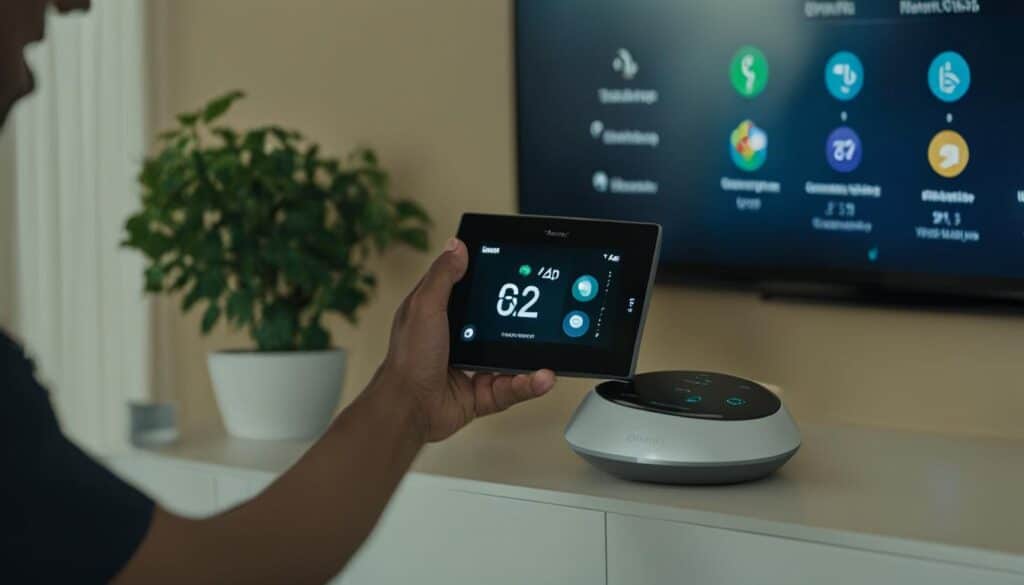Setting up a smart home network can transform your living space into a seamlessly connected and automated haven. With the constant advancements in smart home technology, the possibilities for creating a personalized and convenient home environment are endless. However, navigating the process of setting up a smart home network can be overwhelming, especially with the wide range of options and devices available in the market.
In this step-by-step guide, I will walk you through the process of setting up a smart home network effectively. From choosing the right ecosystem to establishing a reliable Wi-Fi connection, connecting and configuring devices to enhancing security and privacy, we will cover all the essential aspects to ensure a smooth and hassle-free experience with your smart home automation.
By following this guide, you will gain the knowledge and confidence to embark on your smart home journey, harnessing the power of technology to enhance convenience, efficiency, and comfort in your daily life.
Table of Contents
Key Takeaways:
- Choosing the right ecosystem is crucial for a seamless and integrated smart home experience.
- A reliable Wi-Fi connection is essential for connecting and controlling smart home devices.
- Proper configuration and organization of smart home devices enhance convenience and ease of use.
- Security and privacy measures should be prioritized to protect your smart home network and data.
- Troubleshooting and regular maintenance ensure optimal performance of your smart home network.
Choosing the Right Ecosystem
Before you embark on setting up your smart home network, it’s crucial to choose the right ecosystem. The main options available in the market are Google Home, Amazon Alexa, and Apple HomeKit. Consider factors like compatibility with your existing devices and personal preferences to make an informed decision. Each ecosystem has its own strengths and weaknesses, so thorough research is key to selecting the one that best suits your needs.
To help you make an informed decision, here’s a comparison of the three popular ecosystems:
| Ecosystem | Pros | Cons |
|---|---|---|
| Google Home | Wide range of compatible smart home devices | Limited support for Apple devices |
| Amazon Alexa | Broad device compatibility and extensive skills | Privacy concerns and limited Google integration |
| Apple HomeKit | Tight integration within the Apple ecosystem and strong privacy features | Smaller selection of compatible devices compared to other ecosystems |
Consider your unique needs, device compatibility, privacy concerns, and the level of integration you desire with other smart home devices and services. While these ecosystems may differ in certain aspects, they all offer reliable smart home experiences.
Once you have chosen the ecosystem that aligns with your requirements, you can proceed to set up your wireless home network and explore the vast array of smart home devices available for a truly connected and convenient home environment.

Continue reading to learn how to establish a reliable Wi-Fi connection for your smart home network and optimize your smart home setup.
Establishing a Reliable Wi-Fi Connection
A reliable Wi-Fi connection is crucial for a smooth smart home experience. Most smart home devices operate on the 2.4 GHz frequency, but newer devices may also support the faster 5 GHz frequency.
I recommend upgrading your router to support the latest Wi-Fi protocols, such as Wi-Fi 6E, for improved performance and security. Wi-Fi 6E offers faster speeds, lower latency, and better capacity, allowing your smart home devices to operate seamlessly.
When setting up your Wi-Fi network, consider optimizing the placement of your router to ensure optimal coverage throughout your home. Place the router in a central location, away from obstacles such as walls and large furniture. Avoid placing it near other electronic devices that may cause interference.
To prevent Wi-Fi congestion, it’s essential to manage your network effectively. Set up separate networks for different device types, such as one for smart home devices and another for personal devices. This helps prioritize smart home traffic and minimize interference from other connected devices.
Benefits of Establishing a Reliable Wi-Fi Connection:
- Smooth and uninterrupted control of your smart home devices
- Faster response times for voice commands and automation
- Enhanced security and privacy measures with the latest Wi-Fi protocols
- Improved performance and stability for streaming, gaming, and other online activities
- Optimal coverage throughout your home, eliminating dead zones
“A reliable Wi-Fi connection is the backbone of your smart home system. It ensures that your devices communicate seamlessly and respond promptly to your commands.”
Connecting and Configuring Smart-Home Devices
Now that you have successfully set up your ecosystem and established a reliable Wi-Fi connection, it’s time to connect and configure your smart-home devices. Following the manufacturer’s instructions, you can easily set up each device and link them to your chosen ecosystem. This will allow you to control and automate your devices, creating a seamless smart home experience.
Take the time to assign unique names to each device and organize them into groups for easier control. For example, you can group all your smart lights together or create a separate group for your security cameras. This way, you can control multiple devices with a single command or schedule actions to occur simultaneously.
“Grouping your devices not only simplifies control but also enhances the automation capabilities of your smart home.”
In addition to basic device configuration, modern smart home control systems offer advanced customization options. You can automate routines and create smart-home shortcuts to streamline your daily tasks. For example, you can create a “Good Morning” routine that turns on the lights, adjusts the thermostat, and plays your favorite music when you wake up.
By taking advantage of these advanced configuration options, you can truly personalize your smart home to fit your lifestyle and preferences. Whether it’s setting the perfect lighting scene for movie night or automatically adjusting the temperature based on your schedule, the possibilities are endless.
Furthermore, integrating voice assistants such as Google Assistant or Amazon Alexa into your smart home system can provide hands-free control. Simply issue voice commands and watch as your devices respond accordingly. Imagine dimming the lights or locking your doors with just a simple voice command.
With the right combination of smart devices and a well-configured control system, you can create a truly intelligent home that enhances your daily life.
Examples of Smart-Home Device Configuration
| Device | Configuration Steps |
|---|---|
| Smart Lights |
|
| Smart Thermostat |
|
| Smart Security System |
|
Once you have connected and configured your smart-home devices, you are one step closer to enjoying the convenience and automation of a smart home.

Enhancing Security and Privacy
Security is an essential aspect of setting up a smart home network. By taking a few simple steps, you can ensure that your home network installation is secure and your smart home technology is protected.
To begin, it is crucial to choose a strong and unique password for your Wi-Fi network. This will help prevent unauthorized access to your network and the devices connected to it. Avoid using common passwords or personal information that can be easily guessed.
Enabling encryption is another important security measure. Encryption scrambles the data transmitted between your devices and the router, making it difficult for hackers to intercept and decipher. Most modern routers support WPA2 or WPA3 encryption protocols, which provide robust security for your smart home network.
Consider creating a separate network for your smart home devices. This can help isolate them from other devices on your network, adding an extra layer of security. By doing so, you can minimize the risk of a compromised smart device affecting other devices or accessing sensitive information.
Regularly updating the firmware of your smart home devices is crucial for maintaining security. Manufacturers often release updates that patch security vulnerabilities and improve device performance. Check for firmware updates periodically and apply them as soon as they become available.
Take advantage of security features such as two-factor authentication when setting up your smart home devices. This adds an extra layer of protection by requiring a second verification step, such as a code sent to your mobile device, in addition to your password. Enable this feature whenever possible to enhance the security of your smart home network.
To ensure your data is handled responsibly, it is essential to review the privacy policies of your chosen ecosystem. Understand how your data will be collected, stored, and shared by the ecosystem and adjust settings accordingly. By configuring privacy settings appropriately, you can have greater control over the information shared by your smart home devices.
Overall, prioritizing security and privacy in your home network installation is crucial to protect your smart home technology and personal information. By following these steps and staying vigilant, you can enjoy the convenience and automation of a smart home with peace of mind.
Troubleshooting and Maintenance
Like any technology, smart home networks may encounter issues from time to time. If you experience connectivity or performance problems, try the following troubleshooting steps:
- Reboot your devices: Sometimes a simple restart can solve connectivity issues. Power off your smart home devices, including your router and connected hubs, and then power them back on.
- Check signal strength: Weak Wi-Fi signals can cause problems with smart home devices. Make sure your router is placed in a central location and consider using Wi-Fi extenders or a mesh network to improve coverage.
- Update firmware: Keeping your router and smart home devices up to date with the latest firmware is crucial for optimal performance and security. Check the manufacturer’s website or app for any available updates.
It’s also important to stay updated with firmware and software updates for your devices. Manufacturers often release updates to address bugs, improve compatibility, and add new features. Regularly review and adjust your smart home settings to accommodate any changes in your network or devices.
Common Troubleshooting Issues:
“My smart lights are not responding.”
If your smart lights are not responding, check the following:
- Ensure the lights are properly connected to your network and have power.
- Confirm that the smart light hub or bridge is connected and functioning.
- Check if there are any available firmware updates for your smart lights or the hub/bridge.
- Restart the lights by turning them off and on again.
“My smart thermostat is not showing the correct temperature.”
If your smart thermostat is not displaying the correct temperature, try the following:
- Verify that the thermostat is connected to your Wi-Fi network.
- Ensure the thermostat is properly calibrated and placed away from direct heat sources or drafts.
- Check for any available firmware updates for the thermostat.
- Restart the thermostat and give it time to readjust and sync with your smart home system.
Remember that troubleshooting steps may vary depending on the specific devices and ecosystem you’re using. Consult the manufacturer’s documentation or support resources for device-specific troubleshooting instructions.
| Problem | Solution |
|---|---|
| Slow Wi-Fi speed | Check for signal interference, update your router firmware, or upgrade to a higher-speed internet plan. |
| Smart home devices not connecting | Restart devices, ensure they are properly connected to the Wi-Fi network, and check for firmware updates. |
| Inconsistent device performance | Monitor device placement and signal strength, consider adding Wi-Fi extenders, and update firmware. |
| Intermittent connectivity issues | Optimize router placement, minimize Wi-Fi congestion, and check for interference from other devices or appliances. |
Conclusion
Setting up a smart home network doesn’t have to be a daunting task. By following this comprehensive home network setup guide, you now have the knowledge and tools to create a seamless smart home automation experience.
The process begins with choosing the right ecosystem that aligns with your preferences and existing devices. Whether you prefer the versatility of Google Home, the convenience of Amazon Alexa, or the integration of Apple HomeKit, selecting the right ecosystem sets the foundation for your smart home network.
Establishing a reliable Wi-Fi connection is essential for smooth operation. Upgrade your router to support the latest Wi-Fi protocols and optimize its placement to minimize signal interference. This will ensure a stable connection for all your smart devices.
Once your ecosystem and Wi-Fi connection are in place, connect and configure your smart-home devices according to the manufacturer’s instructions. Remember to keep your devices up to date with firmware updates and take advantage of security features to protect your network and privacy.
Finally, don’t forget to troubleshoot and maintain your smart home network regularly. Stay updated with firmware and software updates, check for connectivity issues, and review and adjust your smart home settings as needed.
With this comprehensive guide, you are now equipped to set up your own smart home network and enjoy the convenience and automation it brings to your daily life.
FAQ
What is a smart home network?
A smart home network is a system that connects and controls various smart devices within your home, allowing you to automate tasks and enhance convenience.
How do I choose the right ecosystem for my smart home network?
Consider factors such as compatibility with your existing devices and personal preferences. Research the available options like Google Home, Amazon Alexa, and Apple HomeKit to find the one that best suits your needs.
Why is a reliable Wi-Fi connection important for a smart home network?
Smart home devices rely on a stable internet connection to communicate, so a reliable Wi-Fi connection is crucial for a smooth and seamless smart home experience.
How can I establish a reliable Wi-Fi connection for my smart home network?
Upgrade your router to support the latest Wi-Fi protocols, such as Wi-Fi 6E, and optimize the placement of your router. Additionally, manage Wi-Fi congestion to ensure a stable connection.
How do I connect and configure my smart-home devices?
Follow the manufacturer’s instructions to set up each device and link them to your chosen ecosystem. Assign unique names to each device and organize them into groups for easier control.
How can I enhance security and privacy in my smart home network?
Choose a strong and unique password for your Wi-Fi network, enable encryption, and consider creating a separate network for smart home devices. Regularly update firmware and enable security features such as two-factor authentication when available.
What should I do if I encounter connectivity or performance issues with my smart home network?
Try troubleshooting steps such as rebooting devices, checking signal strength, or updating firmware. Stay updated with firmware and software updates for your devices and regularly review and adjust your smart home settings.


